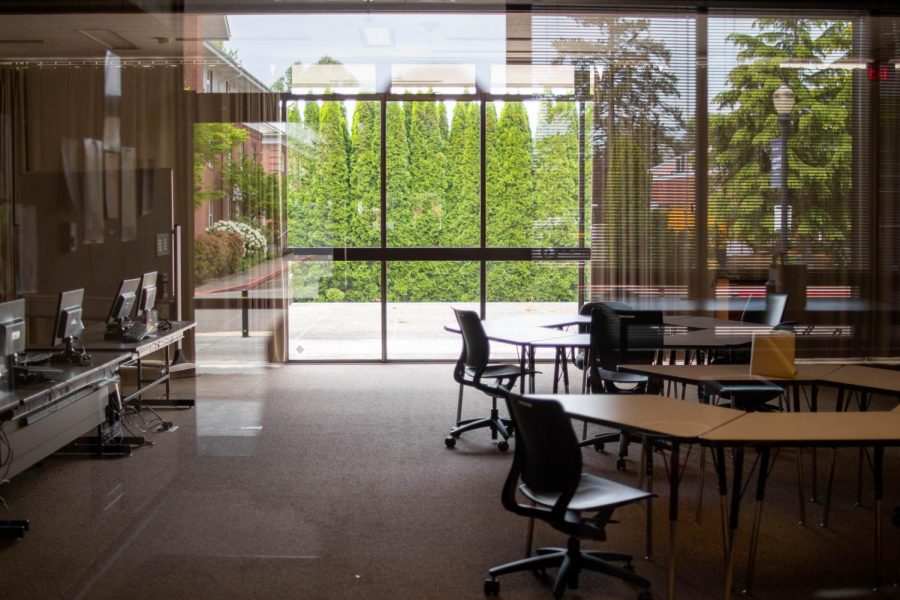In September, students picked produce from the Linfield Community Garden. In October, compost bins for students to put in their kitchen and assorted wastes were made available. In November, vegetation sprouted on the eco-roof of the bike shelter between Elkinton and Terrell halls. What will happen next?
These projects were supported by Linfield’s Strategic Climate Action Plan. Finalized in early September as part of The American College and University Presidents’ Climate Commitment (ACUPCC), the plan was implemented to “balance leadership in sustainability and climate change action with the academic and financial integrity of the institution,” according to the official copy of the plan.
This strategic 28-page plan reviews Linfield’s sustainability achievements during the past 12 years, introduces current factors and ongoing projects to reduce the college’s greenhouse gas emissions and identifies potential opportunities to reduce carbon emissions.
“The plan is a framework for what we actually do,” John Hall, sustainability coordinator and director of capital planning & development, said.
The plan
As defined by the GHG (greenhouse gas) Protocol, a standard for emissions reporting, emissions sources are
divided into three scopes. Each scope takes behavioral and infrastructural sources into account (see figure below).
As part of its commitment to ACUPCC, Linfield aims to reduce the school’s emissions to below the baseline identified in Linfield’s 2007 greenhouse gas emissions inventory by Clean Air Cool Planet Campus Carbon calculator and initially contributed from the environmental studies senior capstone class. Eventually, Linfield anticipates that it will be zero.
“Those [strategies in the plan] are detailed in curriculum or facilities. House sustainability is a significant part of what we’ve been doing. We have saved both emissions and financial resources as we are progressing to the future, for example, renovating Northup Hall to LEED silver,” John McKeegan, Advisor to the President and Co-chair of Advisory Committee on the Environment and Sustainability, said.
The college calculated the efficiency for several potential projects. According to the official documents, one of the projects will remove outdated control systems and replace them with campus standard system which will potentially result in $19,369 annual savings.
Hall said that some of the renovations to T.J. Day Hall (formally Northup Hall) include environmentally friendly technology, such as an energy-saving roof with solar panels to capture sunlight and convert it into electrical energy for the building.
Difficulty and possibility
Since it’s mostly responsible for the Strategic Climate Action Plan, ACES faces challenges with its implementation.
One of the biggest problems is the school’s reluctance toward devoting more resources to making this plan a reality, senior David Kellner-Rode, sustainability intern and a member of ACES, said in an e-mail.
“There are various ways for the college to actually achieve carbon neutrality, but it’s going to be a collaborated effort,” McKeegan said. “I identify alternative strategies [in the plan]. The community as a whole makes some fundamental decisions about which we want to pursue.”
Hall said besides requirements the college got to do including gas emission inventories and climate action plan, Linfield is still struggling as a
community to identify what sustainability means to ACES, what it means to Linfield, not just the 5 percent of students that advocate for it.
McKeegan said he doesn’t want the impression to prevail that Linfield is doing nothing. He also said one thing ACES didn’t do a good job of is letting people know that the college has urged for sustainable actions.
Belief in the future
Kellner-Rode leads three other students on a sustainability work study team that works on Linfield’s 2011 greenhouse gas emissions inventory and will release a new report next May.
“Hopefully, [the new greenhouse gas inventory] will give [people] a clear picture of where we are and whether initial projection that we are going to see is correct. Then we will decide potential strategies,” McKeegan said.
Hall praised Kellner-Rode and other students who are involved in increasing sustainability on campus. He said their passion helps push the process of the plan.
Hall said that strategic plan is the first step, and that the college needs to look at additional details to develop a specific action plan with one or two more steps.
“A good next step is to engage the Linfield community, and tell them the plan exists,” Kellner-Rode said.
by Jaffy Xiao/Features editor,
Jaffy Xiao can be reached at [email protected].
Notable numbers from the Strategic Climate Action Plan:
In an effort to reduce energy consumption for heating, cooling, hot water production and lighting, Linfield has developed a Comprehensive Energy Conservation Plan, which has yielded extraordinary results. During the last 10 years, Linfield College has implemented many energy efficiency conservation projects saving $2.2 million in operating costs.
During the spring and summer of 2009, the college implemented lighting retrofits in many of its buildings. These retrofits included reducing the number of lamps in a fixture by half and installing high-quality reflectors. The combination of new, high-efficiency T8 lamps, new generation ballast and reflectors created significant savings along with the installation of double pane windows in the college apartments. Total electrical savings came to 528,009 Kilowatt hours per year.
Although Linfield has no Scope 2 emissions from purchased electricity as calculated by the Clean Air Cool Planet calculator, the college recognizes the benefit of reducing electricity usage. Regional and national sources of carbon neutral electricity are limited, and by reducing Linfield’s electricity usage, capacity is made available to others. Linfield has calculated that the use of hydroelectric and wind power instead of regional average electricity sources allows Linfield to avoid emissions of 4,800 MT carbon dioxide equivalent annually, or an increase of 60 percent of the emissions calculated. This knowledge will allow Linfield to demonstrate the impact of future reductions in electrical usage.
Linfield students have participated in so many cultural travel programs that 26 percent of Linfield’s GHG inventory comes from study abroad air travel. This is a higher emission impact compared with the average eight percent of emissions from air travel calculated by other colleges that have signed the ACUPCC.







